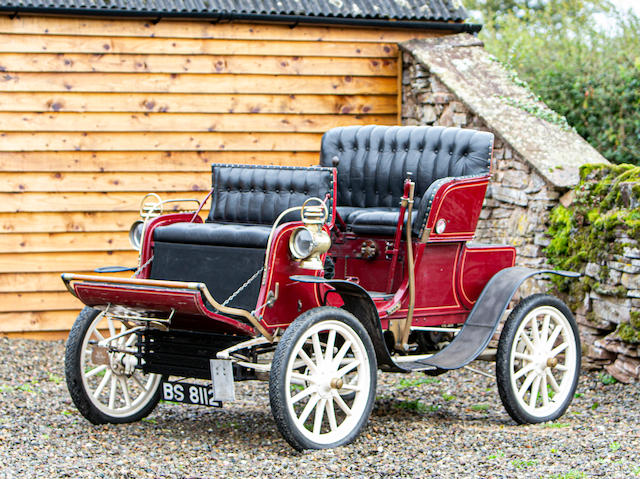FEATURED AUCTION
BONHAMS AUCTIONS
London to Brighton Sale
Friday 1st November 2019
New Bond Street Saleroom, London
1903 Stevens-Duryea 7hp Twin-Cylinder Model L Stanhope
Registration no. BS 8112
Chassis no. 317
*Pioneering American make of high quality
*Restored in the UK in the 1990s
*Many-time LBVCR finisher
*Entered in the 2019 LBVCR
- Cars bearing the 'Duryea' name can claim an impressive record of automotive 'firsts'. Founded in Chicopee, Massachusetts in 1895 by brothers Charles E and J Frank Duryea, the Duryea Motor Wagon Company was the United States' first dedicated to the manufacture of gasoline-powered cars having tested its first such automobile - also America's first - in 1893. In 1895 a Duryea driven by J Frank, accompanied by his brother, won the Chicago Times-Herald contest, the first automobile race held in the United States. Production started that same year and the Duryea became America's first commercially produced car.The following year a pair of Duryea's was shipped to the UK for the first London to Brighton Emancipation Run, one of which, driven by J Frank, was the first to arrive in Brighton, beating the next closest arrival by more than an hour. The Duryea's' participation marked the first appearance of American motor vehicles in Europe. On a more sombre note, the USA's first recorded car accident involved a Duryea, when in 1896 New Yorker Henry Wells hit a cyclist. The cyclist broke his leg and Wells spent a night in jail.Within a few years the Duryea brothers had fallen out and the partnership dissolved. Charles E moved to Reading, Pennsylvania where the production of Duryea motor cars recommenced in 1900, while J Frank forged an alliance with the J Stevens Arms & Tool Company of Chicopee Falls, where his new prototype, originally built under the Hampden brand name, commenced production in 1901 as the Stevens-Duryea.A wire-wheeled, tiller-steered runabout, Stevens-Duryea's first product was powered by a 5hp, twin-cylinder, horizontal engine and sold for $1,200. No production numbers are known for 1901, but 61 cars were built in 1902 and 483 in 1903. By 1904 the runabout had undergone considerable development; now designated 'Model L', it featured a tubular chassis and was powered by a 6hp horizontal twin mounted amidships. Tiller steering was retained, while other noteworthy features included fully elliptic springing, wire wheels, and a three-speeds-plus-reverse gearbox. The Model L weighed 1,300lb (590kg) and sold for $1,250.A 20hp four-cylinder model was added to the range for 1905 while a 50hp shaft-driven six was a new introduction for 1906, the final year of runabout production. By this time, Stevens-Duryea's reputation as a maker of expensive high-quality motor cars was firmly established. Running at some 100 cars per year, production mostly consisted of large touring cars and limousines.In 1915, production stopped because of financial problems and the Stevens-Duryea plant was sold to the New England Westinghouse Company, which need the facility for war work. After WWI, several former employees bought the name, rights, and goodwill, and restarted production in 1919 of the 46hp six-cylinder Model D, now designated Model E and priced at a eye-watering $9,500 (Vestibule Limousine and Sedan models) when the average wage in the USA was less than $3,300. Stevens-Duryea staggered on for a few more years, undergoing various changes of ownership and reorganisation, before finally closing its doors in 1927.A letter on file from the Horseless Carriage Club of America records this Stevens-Duryea's date of build as 1903, which is confirmed by dating certificates from the Science Museum and VCC. Owned from 1960 to 1990 by Homer Fitterling of Florida, the car was purchased by John Hearne and imported into the UK in 1991. It was restored during Mr Hearne's ownership and enthusiastically enjoyed, as evidenced by the numerous expired MoTs and tax discs on file dating from this period.The Stevens-Duryea was purchased by the current vendor's father in June 2001, since when it has shared a garage with the Salveston Steamer and many other important Veteran and Edwardian cars. Used with success on the Red Flag Run, it was an LBVCR finisher in 2003, 2004, 2005, 2006, 2007, 2013, and 2016, only retiring in 2018 due to the heavy rain! Serviced annually by Hicky Hickling and well maintained, it has replacement Rodney Fowler chains and new valves made by Ian Nuthall (IN Racing), while other noteworthy features include deep-buttoned leather seats and Orient brass front lamps. Possessing an entry to the 2019 LBVCR, this wonderful American Veteran is presented in good condition and running well.
-
SELECTED BY THE SQUIRREL
I'm NUTS ABOUT CLASSICS
Disclaimer: Whilst Classic Chatter ("we") attempt to make sure that the information contained in this website is accurate and complete, we are aware that some errors and omissions may occur from time to time. We are not able, therefore, to guarantee the accuracy of that information and cannot accept liability for loss or damage arising from misleading information or for any reliance on which you may place on the information contained in this website. We highly recommend that you check the accuracy of the information supplied. If you have any queries about any information on our website, please contact us at jeff.classicchatter@mail.com
CLASSIC CHATTER
Powered By Dragons












No comments:
Post a Comment